When it comes to dog behavior and physical characteristics, one of the most frequently asked questions is about the concept of lock jaw. This term often conjures images of dogs clamping down with an unstoppable, vice-like grip, but is it based in fact or is it a myth? This article will guide you through the truth about lock jaw in dogs, the breeds most commonly associated with this trait, and how to handle situations where a dog seems unable to release its grip.
Table of Contents
- Understanding Lock Jaw
- Breeds Associated with Lock Jaw
- Dealing with a Dog’s Strong Grip
- FAQs
Key Takeaways
- The concept of lock jaw in dogs is largely a myth.
- Some breeds have stronger jaw muscles than others.
- Training and proper handling are essential to manage a dog’s bite.
Understanding Lock Jaw
The term ‘lock jaw’ is often associated with pit bull breeds, and implies that once these dogs bite down on something, their jaws lock into place and cannot be opened until they choose to release. However, this is largely a myth. No dog breed has a specific anatomical feature that would enable their jaws to lock into place.
The American Veterinary Medical Association confirms that lock jaw in dogs is a myth. Dogs, like humans, have temporomandibular joints connecting the jawbone to the skull, and these joints function in the same way across all breeds. What differs among breeds is the strength of their bite, which is determined by the size of the dog and the power of their jaw muscles.
For more detailed information about dog anatomy and behavior, you can refer to this article.
Breeds Associated with Lock Jaw
While no breed has a true lock jaw, some breeds are known for having particularly strong jaw muscles. These include:
-
Pit Bulls: Despite the myth of the lock jaw, Pit Bulls do have powerful jaws and a strong bite. They were historically bred for bull-baiting, which required a strong grip.
-
Rottweilers: These large dogs have a bite force of over 300 pounds per square inch, making them one of the breeds with the strongest bite.
-
German Shepherds: Known for their intelligence and versatility, German Shepherds also boast a strong bite force.
-
Mastiffs: These giant dogs have powerful jaws, but they are known to be gentle unless provoked.
Remember, a dog’s behavior is more influenced by its training and socialization than its breed. A well-trained, well-socialized dog is unlikely to bite without reason, regardless of the strength of their jaw.
Dealing with a Dog’s Strong Grip
Training and proper handling are essential to manage a dog’s bite, especially if the dog belongs to a breed with a strong jaw.
Here are some tips:
-
Training: Train your dog to release objects on command. Use phrases like “drop it” or “let go” consistently.
-
Socialization: Expose your dog to a variety of situations, people, and other animals to ensure they are comfortable and relaxed in different environments.
-
Exercise: Regular exercise can help manage a dog’s energy levels and reduce the likelihood of aggressive or destructive behavior.
If you’re dealing with a persistent issue, consider seeking professional help. A professional dog trainer or behaviorist can provide useful insights and strategies. Check out this guide for more information.
Frequently Asked Questions
1. Do Pit Bulls have lock jaw?
No, Pit Bulls do not have lock jaw. This is a myth. Pit Bulls do have strong jaw muscles, but they do not have any mechanism that would enable their jaws to lock.
2. Which dog breed has the strongest bite?
The Kangal, a breed from Turkey, is known to have the strongest bite, with a bite force of over 700 pounds per square inch.
3. Can a dog’s jaw get stuck?
Yes, a dog’s jaw can get stuck if they bite down on an object that’s too large or awkward for their mouth. If this happens, seek veterinary assistance.
4. Is lock jaw dangerous for dogs?
Since lock jaw is a myth, it’s not a risk for dogs. However, a dog with a strong bite could potentially cause injury to others if not properly trained and managed.
In conclusion, while the concept of lock jaw in dogs is largely a myth, understanding a dog’s jaw strength and training them appropriately is crucial for the safety and well-being of both the dog and those around it.



